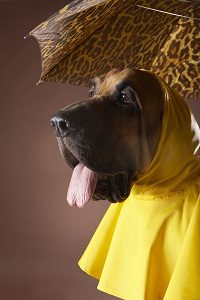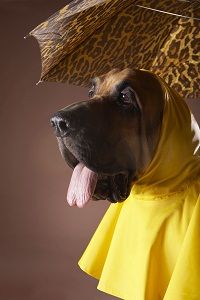Can dogs predict the weather?
We loved this article By Ralph Greco, Jr.
“Dog Alerts Owner to Bad Weather”
 It sounds like a headline from a supermarket tabloid but scientific facts support this seemingly amazing claim — which is not so amazing to those of us who own dogs. So many of us have experienced our furry companions barking well before we hear thunder, or have come to enjoy the old head-in-our-lap cuddle just before rain pelts our house.
It sounds like a headline from a supermarket tabloid but scientific facts support this seemingly amazing claim — which is not so amazing to those of us who own dogs. So many of us have experienced our furry companions barking well before we hear thunder, or have come to enjoy the old head-in-our-lap cuddle just before rain pelts our house.
How often do we find our dogs jumping for joy just about the time we hear our weatherman warning of an imminent snowstorm? We’ve all heard those not-so-tall tales of a family’s dog barking so loudly that they alert everyone to danger well before a tornado is even detected. The connection between imminent weather changes and our dogs knowing about them before we do, and often times their trying to tell us about them, is something so many of us have experienced or heard about that we seldom actually question this simple fact of doggy derring-do.
It’s less a canine “sixth sense” though, than it is a case of simple science.
A dog is more sensitive to the drop in barometric pressure and the shift in the static electric field that comes prior to climate changes. With severe weather imminent, like the often quick turn-about a tornado brings, or the severe conditions in the wake of an approaching hurricane, a dog will not only feel those acute changes in electricity and air pressure — all that much more acute in severe weather — but beyond warning their households, they have been known to seek shelter themselves.
Have you ever stepped out of your house, taken a hearty inhale and said, “Mmm, it certainly smells like rain?” Well, if you can sniff out that scent, your dog can too — their noses can detect concentrations of chemicals we couldn’t even imagine. When it comes to the smell of ozone in the air attributed to lightning, rest assured your pooch will smell it before you do!
And what about far-off thunder? Canine hearing is close to twenty times more sensitive than ours. Those rumbles we might not even hear until they are upon us as full-blown thunder are sounds and vibrations your dog will certainly hear or feel well before you This is why all that rattling really disturbs some dogs when it finally arrives in full fury.
Our dog’s senses are that much more sensitive than ours, so is it any wonder that they can detect the nuances of weather changes better than we ever could? If we can learn to recognize and interpret specific behaviors our dogs are instinctively revealing before those weather changes are upon us, we might learn to figure out what is literally “on the horizon.”
Although other animals, from cats to birds to turtles, are known to exhibit behavior related to anticipating storms or changes in the weather, researchers theorize that, because of the way dogs learn, the more often they are exposed to weather changes, the more they will learn to anticipate those changes — and then the changes that come before those, and so on, until they have learned to associate the tiniest of changes with what they have experienced before… and then will surely want to “tell” us about them.
Ultimately, we might be better off enjoying a good warm furry cuddle or heeding that loud consistent barking over watching the Weather Channel.
Does your dog warn you of impending changes in the weather, incoming tornadoes, or earthquakes? Tell us about your experiences in the comments!




